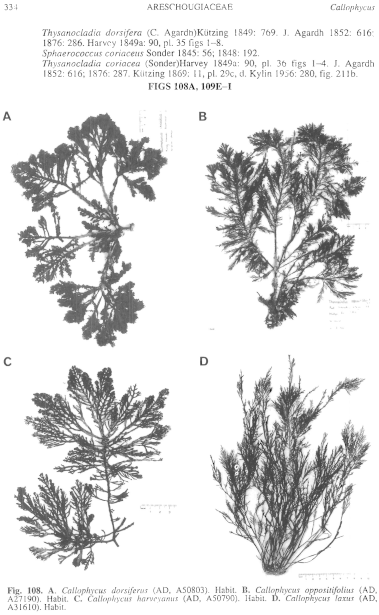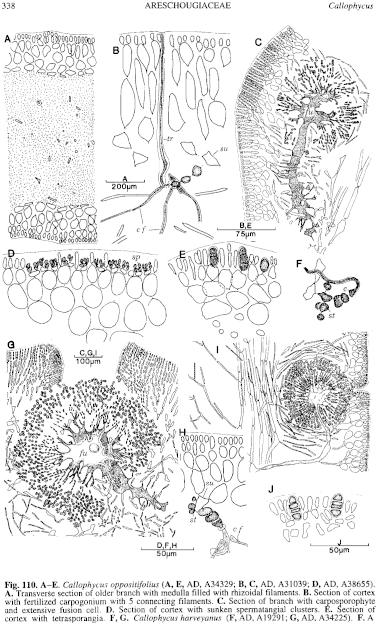|
|
|
|
|
|||||||||||
|
Electronic Flora of South Australia Species Fact Sheet
Phylum Rhodophyta – Class Florideophyceae – Order Gigartinales – Family Areschougiaceae
Selected citations: Min-Thein & Womersley 1976: 23, figs 7, 8, 51B, 52A.
Synonyms
Sphaerococcus oppositifolius C. Agardh 1822: 294.
Thysanocladia oppositifolia (C. Agardh) J. Agardh 1852: 617; 1876: 288. Harvey 1862: pl. 187. Kützing 1869: 11, p1. 30a, b.
Thallus (Fig. 108B) dark red-brown, 10–30 cm high, with a short terete to compressed stipe producing several axes. Axes complanately branched, (2–) 4–5 mm broad and 0.8–1.2 mm thick, bearing crowded, slender, marginal, pinnate branches, becoming denuded below but often proliferous from the margins. Pinnae (2–) 4–12 cm long, 1–2 mm broad, bearing distichous and subopposite pinnules 1–3 cm long and 0.5–1 (–1.5) mm broad, subterete to compressed, sometimes similarly branched. Holdfast robust, discoid, crustose, 0.5–3 cm across; epilithic. Structure (Fig. 110A) multiaxial, developing a dense medulla of irregular longitudinal filaments, with rhizoids, and a pseudoparenchymatous cortex 4–5 cells thick, inner cells ovoid, 15–40 (–50) µm in diameter, decreasing to the outer cells 3–5 µm in diameter. Rhodoplasts discoid, several to many per cell.
Reproduction: Sexual thalli dioecious; non-procarpic. Carpogonial branches 3-celled, borne on inner cortical cells, inwardly directed with reflexed trichogynes, often with a sterile cell on the basal cell. Connecting filaments (Fig. 110B) 3–5, unbranched and non-septate. Auxiliary cells inner cortical cells, with adjacent cells becoming darker staining after diploidization, first developing gonimoblast initials inwardly and later radially from the fusion cell (Fig. 110C) which develops a stalk of fused medullary cells; carposporangia in short chains, ovoid, 5–8 µm in diameter. Cystocarps often adjacent, bulging near the pinnule edge, with slight enveloping tissue, ostiolate. Spermatangia (Fig. 110D) scattered on young branches, cut off from outer cortical cells often with interspersed sterile cells, ovoid, 2–3 µm in diameter.
Tetrasporangia (Fig. 110E) scattered in the outer cortex near branch ends, among elongate sterile cells, basally attached, elongate-ovoid, 15–25 µm long and 7–10 µm in diameter, zonately divided.
Type from "Nov. Ho11." (Desfontaines); holotype in Herb. Agardh, LD, 25599; isotype in PC.
Selected specimens: Point Moore, Geraldton, W. Aust., drift (Womersley, 17.ix.1979; AD, A51178). Flat Rocks, 40 km S of Geraldton, W. Aust., drift (Mitchell, 17.ix.1966; AD, A31039). Parakeet Bay, Rottnest I., W. Aust., 6 m deep (Mercer, 7.xii.1984; AD, A56647). Point Peron, W. Aust., drift (Parsons, 15.xi.1968; AD, A34329). Safety Bay, W. Aust., drift (Womersley, 18.viii.1979; AD, A50759 -"Marine Algae of southern Australia" No. 206). Elliston, S. Aust., 17 m deep outside bar (Shepherd, 12.v.1971; AD, A38655). 7 km SE of Wedge I., S. Aust., 23–38 m deep (Baldock, 4.i.1964; AD, A27190). Cable Hut Bay, Yorke Pen., S. Aust., 2–9 m deep (Kalil, 10.vi.1968; AD, A33074). Seal Bay, Kangaroo I., S. Aust., drift (Womersley, 29.x.1966; AD, A31026).
Distribution: Geraldton, W. Aust., to Seal Bay, Kangaroo I. and southern Yorke Pen., S. Aust.
Taxonomic notes: C. oppositifolius is distinguished by the slender, often proliferous, lateral pinnae and pinnules borne on the distinctly broader, thick, axes. It is essentially a deep water species of western affinities.
References:
AGARDH, C.A. (1822). Species Algarum. Vol. 1, Part 2, pp. 169–398. (Berling: Lund.)
AGARDH, J.G. (1852). Species Genera et Ordines Algarum. Vol. 2, Part 2, pp. 337–720. (Gleerup: Lund.)
AGARDH, J.G. (1876). Species Genera et Ordines Algarum. Vol. 3, Part 1 - Epicrisis systematis Floridearum, pp. i-vii, 1–724. (Weigel: Leipzig.)
HARVEY, W.H. (1862). Phycologia Australica. Vol. 4, Plates 181–240. (Reeve: London.)
KÜTZING, F.T. (1869). Tabulae Phycologicae. Vol. 19. (Nordhausen.)
MIN-THEIN, U. & WOMERSLEY, H.B.S. (1976). Studies on southern Australian taxa of Solieriaceae, Rhabdoniaceae and Rhodophyllidaceae (Rhodophyta). Aust. J. Bot. 24, 1–166.
SILVA, P.C. (1957). Remarks on algal nomenclature. Taxon 6, 141–145.
The Marine Benthic Flora of Southern Australia Part IIIA complete list of references.
Publication:
Womersley, H.B.S. (14 January, 1994)
The Marine Benthic Flora of Southern Australia
Rhodophyta. Part IIIA, Bangiophyceae and Florideophyceae (to Gigartinales)
Reproduced with permission from The Marine Benthic Flora of Southern Australia Part IIIA 1994, by H.B.S. Womersley. Australian Biological Resources Study, Canberra. Copyright Commonwealth of Australia.
Illustrations in Womersley Part IIIA, 1994: FIGS 108B, 110 A–E.

Figure 108 enlarge
Fig. 108. A. Callophycus dorsiferus (AD, A50803). Habit. B. Callophycus oppositifolius (AD, A27190). Habit. C. Callophycus harveyanus (AD, A50790). Habit. D. Callophycus laxus (AD, A31610). Habit.

Figure 110 enlarge
Fig. 110. A–E. Callophycus oppositifolius (A, E, AD, A34329; B, C, AD, A31039; D, AD, A38655). A. Transverse section of older branch with medulla filled with rhizoidal filaments. B. Section of cortex with fertilized carpogonium with 5 connecting filaments. C. Section of branch with carposporophyte and extensive fusion cell. D. Section of cortex with sunken spermatangial clusters. E. Section of cortex with tetrasporangia. F, G. Callophycus harveyanus (F, AD, A19291; G, AD, A34225). F. A carpogonial branch with basal sterile cells. G. Section of branch with carposporophyte. H–J. Callophycus laxus (H, I, AD, A38565; J, AD, A10928). H. Section of cortex with fertilized carpogonium with connecting filaments and supporting cell with 3 sterile cells. I. Longitudinal section with a carposporophyte, fusion cell, chains of carposporangia, and lax filamentous enveloping tissue. J. Transverse section of cortex with tetrasporangia. [A–I after Min-Thein & Womersley 1976.]

|
Email Contact: State Herbarium of South Australia |

|